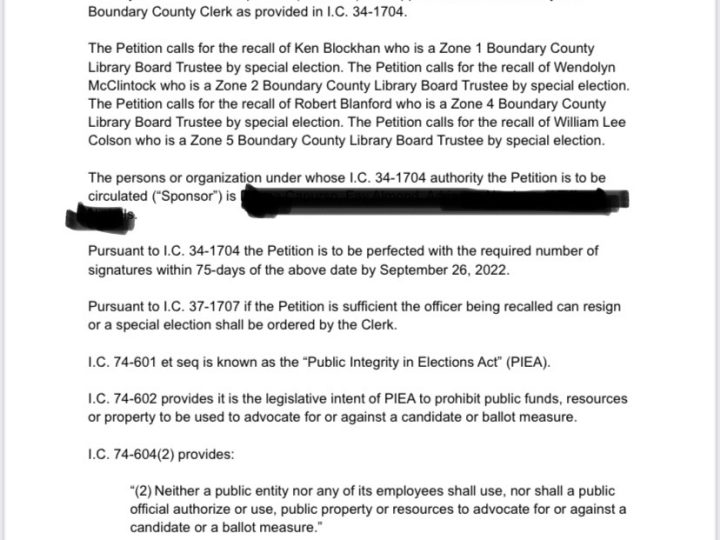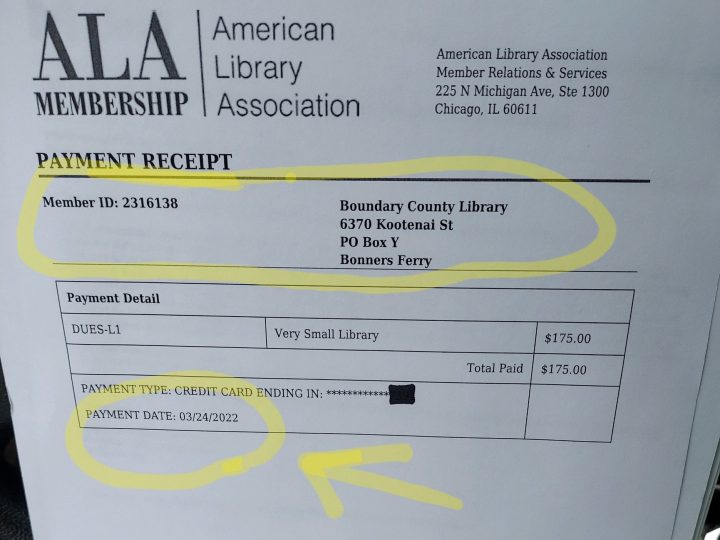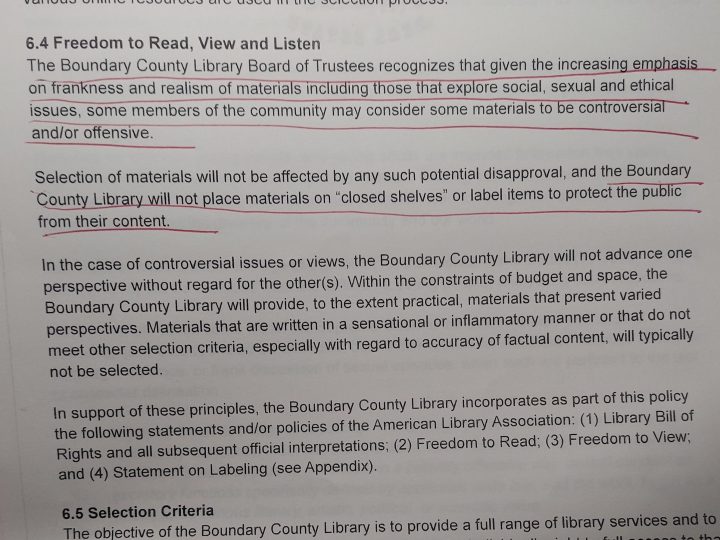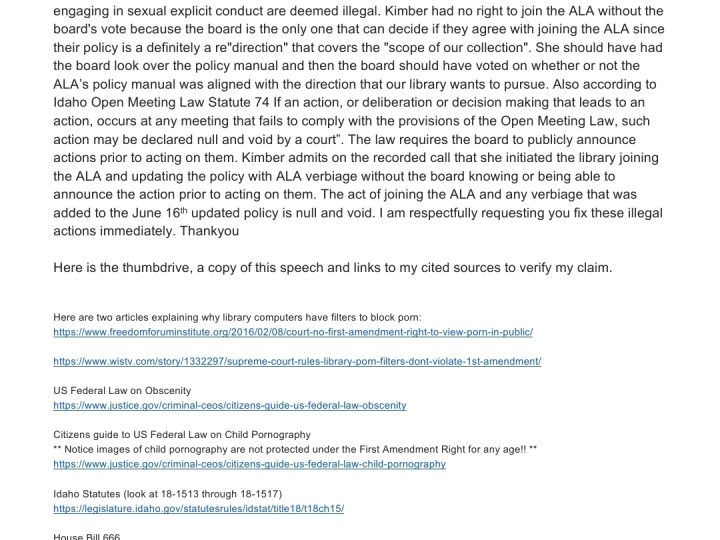
.
September 15, 2022
Letter sent to Boundary County Library Board
by Adrienne Norris
.
On March 24th, former Director Glidden joined the American Library Association without prior authorization or approval from the Board of Trustees. To pay for this membership she used library funds that caused the library to go over budget under the category of ‘Dues and Subscriptions.” This in turn requires the Board to reallocate funds from another budget category to cover that deficit. Because Ms. Glidden was not authorized to spend these funds, and she was not authorized to unilaterally take action to join a membership organization, her unapproved action should be null and void. For this reason, I respectfully request that the Board cure this violation by adding an agenda item at the next scheduled meeting to terminate the membership with the ALA effective immediately. Additionally, I request that the Board adopt a clear policy stating that the Director must receive prior approval from the Board of Trustees before entering into contracts or memberships with third parties and that any future Director be fully comprised of the policies that govern this Library.
Second, on June 16th, this Board did not merely update its collection policy. It adopted an entirely new policy using recommended language obtained from the American Library Association drafted by former Director Glidden without prior authorization of the Board. It is not the job of the Director to draft policy. It is the job of this Board. The policy proposed by Ms. Glidden and adopted by 4 of the 5 Board members may be in accordance with the views of the American Library Association, however it is not in accordance with Idaho Code. The ALA’s views and the views of Ms. Glidden do not take precedence over Idaho Law. Idaho Code 18-1513 states: It is hereby declared to be the policy of the legislature to restrain the distribution, promotion, or dissemination of obscene material, or of material harmful to minors. We do not have to guess about the definition of what Idaho Code considers to be “obscene” because it has been clearly defined in Idaho Code 18-1514. Material is obscene if it portrays: nudity, sexual conduct including any act of masturbation, homosexuality or sexual intercourse. The definition of “materials” is anything tangible which is harmful to minors, whether derived through the medium of reading, observation or sound. Libraries also use the Miller test when deciding which books can lawfully be placed on shelves. Without going into further detail and due to my time constraint of 3 minutes, I will simply say that sexually explicit materials showing sex acts will typically not pass the Miller test adopted by the United States Supreme Court. Therefore, I respectfully request that this Board add as an action agenda item to their next scheduled meeting that they will consider repealing the collection policy adopted on June 16th, and adopt a policy that is in accordance with state and federal laws. This is not a request to ban any books. This has never been a request to ban any books. This is a request that the policies that govern this Library and its collection choices be in accordance with the laws that govern our state. No more, no less. Finally, I respectfully request that the Board remove all the recently updated language from its bylaws that were obtained by associating with the ALA. Thank you for your consideration of these matters. I welcome any further discussion with any Board member regarding these requests.
.
.
.
References:
.
Images of child pornography are not protected under First Amendment rights, and are illegal contraband under federal law. Section 2256 of Title 18, United States Code, defines child pornography as any visual depiction of sexually explicit conduct involving a minor (someone under 18 years of age). Visual depictions include photographs, videos, digital or computer generated images indistinguishable from an actual minor, and images created, adapted, or modified, but appear to depict an identifiable, actual minor. Undeveloped film, undeveloped videotape, and electronically stored data that can be converted into a visual image of child pornography are also deemed illegal visual depictions under federal law. Notably, the legal definition of sexually explicit conduct does not require that an image depict a child engaging in sexual activity. A picture of a naked child may constitute illegal child pornography if it is sufficiently sexually suggestive. Additionally, the age of consent for sexual activity in a given state is irrelevant; any depiction of a minor under 18 years of age engaging in sexually explicit conduct is illegal. Any violation of federal child pornography law is a serious crime, and convicted offenders face severe statutory penalties. For example, a first time offender convicted of producing child pornography under 18 U.S.C. § 2251, face fines and a statutory minimum of 15 years to 30 years maximum in prison. A first time offender convicted of transporting child pornography in interstate or foreign commerce under 18 U.S.C. § 2252, faces fines and a statutory minimum of 5 years to 20 years maximum in prison. Convicted offenders may face harsher penalties if the offender has prior convictions or if the child pornography offense occurred in aggravated situations defined as (i) the images are violent, sadistic, or masochistic in nature, (ii) the minor was sexually abused, or (iii) the offender has prior convictions for child sexual exploitation. In these circumstances, a convicted offender may face up to life imprisonment. It is important to note that an offender can be prosecuted under state child pornography laws in addition to, or instead of, federal law.
.
.
Section 1466A of Title 18, United State Code, makes it illegal for any person to knowingly produce, distribute, receive, or possess with intent to transfer or distribute visual representations, such as drawings, cartoons, or paintings that appear to depict minors engaged in sexually explicit conduct and are deemed obscene. This statute offers an alternative 2-pronged test for obscenity with a lower threshold than the Miller test. The matter involving minors can be deemed obscene if it (i) depicts an image that is, or appears to be a minor engaged in graphic bestiality, sadistic or masochistic abuse, or sexual intercourse and (ii) if the image lacks serious literary, artistic, political, or scientific value. A first time offender convicted under this statute faces fines and at least 5 years to a maximum of 20 years in prison. The standard of what is harmful to minors may differ from the standard applied to adults. Harmful materials for minors include any communication consisting of nudity, sex or excretion that (i) appeals to the prurient interest of minors, (ii) is patently offensive to prevailing standards in the adult community with respect to what is suitable material for minors, (iii) and lacks serious literary, artistic, political, or scientific value for minors. In addition to facing imprisonment and fines, convicted offenders of federal obscenity laws involving minors may also be required to register as sex offenders. Furthermore, in some circumstances, obscenity violations involving minors may also be subject to prosecution under federal child pornography laws, which yield severe statutory penalties
.
.
18-1515. DISSEMINATING MATERIAL HARMFUL TO MINORS — DEFINED — PENALTY. A person is guilty of disseminating material harmful to minors when:
1. He knowingly gives or makes available to a minor or promotes or possesses with intent to promote to minors, or he knowingly sells or loans to a minor for monetary consideration:
(a) Any picture, photograph, drawing, sculpture, motion picture film, or similar visual representation or image of a person or portion of the human body which depicts nudity, sexual conduct or sado-masochistic abuse and which is harmful to minors; or
(b) Any book, pamphlet, magazine, printed matter however reproduced, or sound recording which contains any matter enumerated in paragraph (a) hereof, or explicit and detailed verbal descriptions or narrative accounts of sexual excitement, sexual conduct or sado-masochistic abuse and which, taken as a whole, is harmful to minors; or
(c) Any other material harmful to minors.
2. With reference to a motion picture, show or other presentation which depicts nudity, sexual conduct or sado-masochistic abuse, and which is harmful to minors, he knowingly:
(a) Exhibits such motion picture, show or other presentation to a minor for a monetary consideration; or
(b) Sells to a minor an admission ticket or pass to premises whereon there is exhibited or to be exhibited such motion picture, show or other presentation; or
(c) Admits a minor for a monetary consideration to premises whereon there is exhibited or to be exhibited such motion picture, show or other presentation; or
(d) Exhibits such motion picture, show or other presentation to a minor not for a monetary consideration; or
(e) Gives without monetary consideration to a minor an admission ticket or pass to premises where there is exhibited or to be exhibited such motion picture, show, or other presentation.
Disseminating material harmful to minors is a misdemeanor punishable by confinement in the county jail not to exceed one (1) year, or by a fine not to exceed one thousand dollars ($1,000), or by both such fine and jail sentence.
.
.
18-1514. OBSCENE MATERIALS — DEFINITIONS. The following definitions are applicable to this act:
1. “Minor” means any person less than eighteen (18) years of age.
2. “Nudity” means the showing of the human male or female genitals, pubic area or buttocks with less than a full opaque covering, or the showing of the female breast with less than a full opaque covering of any portion thereof below the top of the nipple, or the depiction of covered male genitals in a discernibly turgid state.
3. “Sexual conduct” means any act of masturbation, homosexuality, sexual intercourse, or physical contact with a person’s clothed or unclothed genitals, pubic area, buttocks or, if such person be a female, the breast.
4. “Sexual excitement” means the condition of human male or female genitals when in a state of sexual stimulation or arousal.
5. “Sado-masochistic abuse” means flagellation or torture by or upon a person who is nude or clad in undergarments, a mask or bizarre costume, or the condition of being fettered, bound or otherwise physically restrained on the part of one who is nude or so clothed.
6. “Harmful to minors” includes in its meaning one or both of the following:
(a) The quality of any material or of any performance or of any description or representation, in whatever form, of nudity, sexual conduct, sexual excitement, or sado-masochistic abuse, when it:
(1) appeals to the prurient interest of minors as judged by the average person, applying contemporary community standards; and
(2) depicts or describes representations or descriptions of nudity, sexual conduct, sexual excitement, or sado-masochistic abuse which are patently offensive to prevailing standards in the adult community with respect to what is suitable material for minors and includes, but is not limited to, patently offensive representations or descriptions of:
(i) intimate sexual acts, normal or perverted, actual or simulated; or
(ii) masturbation, excretory functions or lewd exhibition of the genitals or genital area. Nothing herein contained is intended to include or proscribe any matter which, when considered as a whole, and in context in which it is used, possesses serious literary, artistic, political or scientific value for minors, according to prevailing standards in the adult community, with respect to what is suitable for minors.
(b) The quality of any material or of any performance, or of any description or representation, in whatever form, which, as a whole, has the dominant effect of substantially arousing sexual desires in persons under the age of eighteen (18) years.
7. “Material” means anything tangible which is harmful to minors, whether derived through the medium of reading, observation or sound.
8. “Performance” means any play, motion picture, dance or other exhibition performed before an audience.
9. “Promote” means to manufacture, issue, sell, give, provide, deliver, publish, distribute, circulate, disseminate, present, exhibit or advertise, or to offer or agree to do the same.
10. “Knowingly” means having general knowledge of, or reason to know, or a belief or reasonable ground for belief which warrants further inspection or inquiry.
.
.
Legislature policy:
18-1513. OBSCENE MATERIALS — DISSEMINATION TO MINORS — POLICY. It is hereby declared to be the policy of the legislature to restrain the distribution, promotion, or dissemination of obscene material, or of material harmful to minors, or the performance of obscene performances, or performances harmful to minors. It is found that such materials and performances are a contributing factor to crime, to juvenile crime, and also a basic factor in impairing the ethical and moral development of our youth.
.
.
33-2607. POWERS AND DUTIES OF TRUSTEES. In addition to the powers elsewhere contained in this chapter and notwithstanding the provisions of title 50, Idaho Code, the board of trustees of each city library shall have the following powers and duties:
(1) To establish bylaws for its own governance;
(2) To establish policies and rules of use for the governance of the library or libraries under its control; to exclude from the use of the library any and all persons who violate such rules;
(3) To establish, locate, maintain and have custody of libraries to serve the city, and to provide suitable rooms, structures, facilities, furniture, apparatus and appliances necessary for library service;
(4) With the approval of the city:
(a) To acquire real property by purchase, gift, devise, lease or otherwise;
(b) To own and hold real and personal property and to construct buildings for the use and purposes of the library;
(c) To sell, exchange or otherwise dispose of real or personal property when no longer required by the library; and
(d) To insure the real and personal property of the library;
(5) To prepare and adopt a budget for review and approval by the city council;
(6) To control the expenditures of money budgeted for the library;
(7) To accept or decline gifts of money or personal property, in accordance with library policy, and under such terms as may be a condition of the gift;
(8) To hire, supervise and evaluate the library director;
(9) To establish policies for the purchase and distribution of library materials;
(10) To attend all meetings of the board of trustees;
(11) To maintain legal records of all board business;
(12) To exercise such other powers, not inconsistent with law, necessary for the orderly and efficient management of the library.
0




